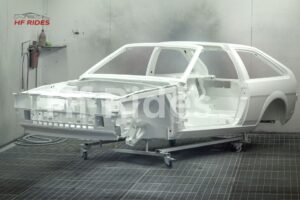Introduction:
If you are wondering how long does it take to paint a car? you are not alone. As you know we are working on this website to provide you the latest and proven car maintenance tips and solving your problems you are facing in your daily driving routine.
At HF Rides, we spent previous weeks gathering expert insights, talking to real auto painters, and analyzing professional timelines to bring you the most accurate, experience backed breakdown available online.
If you are planning a full respray, fixing up a damaged panel, or just worried about the process, This guide covers everything from prep time to aftercare, flash times, and even drying myths. Let’s start by understanding the typical time ranges first.
How Long Each Paint Job Actually Takes?
here’s a general estimate based on the level of work:
- Minor touch ups or spot jobs can take up to 2 to 6 hours
- Partial repaints like hood, bumper can take 1 to 2 days
- Full body professional paint job: 3 to 7 days
- High end custom or showroom finish 2 to 4 weeks
- DIY garage paint job: Can take 1 to 3 weeks depending on tools, prep, and drying space
These ranges vary based on shop workload, paint type, curing conditions, and whether bodywork is involved.
Step by Step Breakdown of the Car Painting Process
If you ever think what really goes into a proper car paint job here is a simple breakdown of how most professional shops actually do it without all the fluff.
Initial Inspection and Quote
First the shop looks over your car checking for rust dents or any previous damage. Based on what they find they’ll give you a rough idea of the cost and what kind of work it’s going to take.
Taking Things Apart Before
Any painting happens they remove stuff like trim lights mirrors and sometimes bumpers. This helps avoid overspray and gives cleaner more complete coverage around edges.
Sanding and Surface Prep
This step takes a lot of time and for good reason. They’ll sand the surface down maybe even to bare metal if needed so the new paint can bond properly. Skipping this part or rushing it will always show later.
Masking and Wipe Down
Once everything is prepped they’ll mask off parts that don’t need paint like windows or wheels then wipe down the surface to get rid of dust grease or fingerprints that can mess up the finish.
Painting Base and Clear
Coats Now comes the actual paint. Usually it’s two to three coats of color then a couple coats of clear to protect the surface and give it shine. They wait a bit between coats to let the layers settle and bond.
Drying or Baking
After painting the car either sits to dry naturally or goes into a heated booth depending on the shop. It can take some hours or even a day.
Reassembly and Final Touches
Once the paint has fully cured usually after 24 to 48 hours they put everything back together.
The thing every expert told us straight up
If you don’t get the prep work right you will never get a good finish. Prepping makes up 70 percent of the entire job. The spraying is just the easy part.
Flash Time in Car Painting: What It Is? And Why It Matters?
Flash time is the short pause between coats, usually 10 to 30 minutes that lets solvents evaporate before adding the next layer. Skipping this leads to major problems like:
- Bubbling or wrinkling
- Uneven finish
- Poor paint adhesion
It’s a step that many DIYers overlook.
Example:
For a base coat in a shop at 75°F, the flash time might be 15 minutes. But in a humid garage? It could be 30+ minutes.
Flash time is affected by:
- Humidity and temperature
- Paint brand and type
- Whether the painter uses air dry or heated booth curing,
we noticed that professionals never skip this step and it is one of the most common causes of failure in amateur paint jobs.
Expert Opinions – What Affects Paint Job Time?
As you know we are gathering real information from experienced auto paint professionals to get clarity on why paint jobs can take anywhere from a few hours to a few weeks? And the truth is, it is not just about how fast someone can spray it’s the little things that impacts on the time.
For starters, the condition of your car plays a important role. If there are dents, rust patches, or previous body repairs, the prep work takes a lot longer. One shop told us flat out, We’ve had jobs where the sanding alone took longer than the painting.
Then there is the type of paint. Not all paints behave the same. Metallics and pearls need more precision and layering, while matte finishes require careful handling to avoid blotches. Also, if you are switching the color of the car entirely like going from black to white expect more steps like extra priming and complete coverage inside door jambs and edges.
The shop’s own workflow matters too. Busy shops often juggle multiple projects, and not every job gets same day turnaround. Plus, if you’re aiming for a showroom level finish instead of a quick respray, that’s going to add both time and steps.
And don’t forget about drying. Air drying in a basic garage takes time, but high end shops with infrared or bake booths can cure paint much faster though you will usually pay for that speed.
One experienced painter summed it up best
You can’t rush quality. We’ve seen one day jobs peel in under a year.
So yes, it is not just paint and a spray gun it is process, precision, and the patience.
Single Stage vs Multi Stage Paint Jobs Time & Finish Compared
The paint system used has a huge impact on both time and finish quality.
Single Stage Paint
- Combines color + clear coat in one
- Faster 1 to 2 days, budget friendly
- Often used for fleet vehicles or older cars
- Less depth, gloss, and UV resistance
Multi Stage Paint (Base + Clear)
- Separate base coat + clear coat layers
- Takes longer: 3 to 7 days, due to extra coats and drying
- Richer finish, stronger protection, better resale value
- Used in professional and OEM paintwork
Post Painting Care What to Do After the Job
Once your car came back with the fresh coating of paint, the work is not completed yet. In fact, the way you care for it during the first few weeks can decide the final result. Most professionals recommend the owners to avoid washing their car for at least 2 weeks, especially with pressure washers. That gives the paint enough time to fully harden and settle. You will also want to hold off on waxing for at least 30 to 60 days. Park it in shade if you can, and definitely avoid tree resin or bird guano those can ruin fresh paint surprisingly fast. Think of this period as a break in phase for your paint.
Can You DIY a Full Paint Job?
A lot of car lovers ask this, and the short answer is yes, you can paint your car at home, but should you? That depends. If you have the right tools, a dust free workspace or Garage, and some solid experience, it’s possible to get decent results with a DIY setup. But here is the truth from the professionals we spoke to painting a car is about 80 percent prep and 20 percent spray. And that prep? It’s bad, time consuming, and requires real attention to detail. One small oversight can lead to paint runs, fisheyes, or worse peeling down the line. If you are just refreshing a beater or learning the ropes, go for it. But for anything that matters in terms of resale or long term finish, professional work usually pays off.








1 thought on “How Long Does It Take To Paint A Car? The Ultimate Guide”